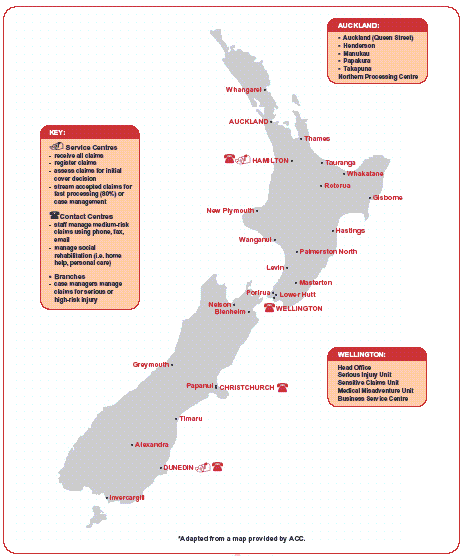Part 2: Background to ACC and Case Management
- Introduction
- Background to the Accident Compensation Scheme
- Legislative concepts
- Claims processing overview
- Case management method
- Corporate philosophy
- Organisational structure
Introduction
2.1
In this part we provide background information about ACC’s approach to case
management, including:
- background to the accident compensation scheme;
- legislative concepts;
- claims processing overview;
- case management method;
- corporate philosophy; and
- organisational structure.
Background to the Accident Compensation Scheme
2.2
ACC was established in 1974 on the introduction of a comprehensive, no-fault
accident compensation scheme. The private rights of individuals to sue for
damages for personal injury were replaced with a public scheme of universal
coverage that aimed to provide compensation for all accidents, wherever they
occurred. At the time, this scheme was world-leading.
2.3
In the three decades since then, the accident compensation scheme has
undergone several major legislative reforms. The latest reform occurred with the
enactment of the Injury Prevention, Rehabilitation, and Compensation Act 2001
(the Act).
2.4
Although widely referred to as accident “compensation”, over the years the
scheme has been given a progressively stronger legislative focus on rehabilitation
(and on injury prevention, but that matter is outside the scope of this audit).
The Act now says that:
… where injuries occur, [ACC’s] primary focus should be on rehabilitation with the goal of achieving an appropriate quality of life through the provision of entitlements that restores to the maximum practicable extent a claimant’s health, independence, and participation.10
Legislative Concepts
2.5
Figure 1 below, and the following text, outline the legislative framework for
the accident compensation scheme.
Figure 1
Legislative Framework of the Accident Compensation Scheme
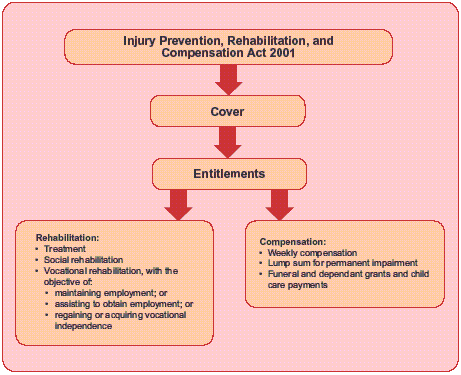
2.6
Before discussing ACC’s compliance with the Act, we define and discuss parts of
the Act that are shown in Figure 1, namely cover and entitlements, before looking
more closely at the rehabilitation aspect of entitlements.
Cover
2.7
A person has cover11 when they have a personal injury (as defined by the Act) that
is within the scope of the Act. The accident compensation scheme was designed
to encompass accidents, but not sickness, and this remains the case.
2.8
In general, cover applies to:
- personal injury caused by an accident;
- personal injury caused by medical misadventure;
- personal injury caused by a work-related gradual process, disease, or infection;
- mental injury caused by certain criminal acts; and
- some other related matters.
2.9
Cover does not include:
- many ailments that occur gradually, such as through ageing (as opposed to conditions that are caused by a specific incident or series of incidents);
- many episodes that are wholly internal (such as strokes and heart attacks);
- many ailments that are caused by viruses, bacteria, or fungi;
- injuries to teeth from natural use; or
- emotional effects of injuries.
2.10
The precise limits to cover have required increasingly complex definition over
the years, and are spelled out comprehensively in the Act. Terms such as “personal injury” and “accident” have detailed and technical meanings.12
Entitlements
2.11
Entitlements13 are the services and benefits that a person who has cover may be
able to receive under the accident compensation scheme. The precise extent of
entitlements is defined in detail in the Act. The range of entitlements includes:
- rehabilitation;
- weekly compensation14;
- lump sum compensation for permanent impairment; and
- certain other grants and payments.
2.12
Where a claimant has cover, ACC is to provide information about entitlements,
and to facilitate access to them. These entitlements come with obligations for
claimants too. They are expected to co-operate with ACC and to participate in
rehabilitation.
Rehabilitation
2.13
Of these entitlements, our audit was mainly interested in rehabilitation.
Rehabilitation15 means:
- treatment;
- social rehabilitation; and
- vocational rehabilitation.
2.14
ACC does not provide medical treatment. Rather, it funds the provision of the
necessary treatment and, where necessary, helps organise treatment services for
the claimant.
2.15
The purpose of social rehabilitation is to assist in restoring a claimant’s
independence to the maximum extent practicable. Social rehabilitation may
include aids and appliances, attendant care, child care, home help, and transport
for independence.
2.16
The purpose of vocational rehabilitation is to help a claimant maintain or
obtain employment, or to regain or acquire vocational independence. Vocational
rehabilitation can include:
- purchases or modifications of workplace equipment;
- help with planning for part-time work, with a gradual increase in hours or tasks;
- training for job-seeking; and
- training to build on a claimant’s existing skills and preparing them to enter a new occupation.
2.17
Vocational independence16 means a claimant’s capacity to engage in work for
which he or she is suited (by reason of experience, education or training) for at
least 35 hours a week. If ACC determines a claimant to have vocational
independence, he or she is considered to be rehabilitated. The claimant is expected
to be able to obtain full-time work, and so loses his or her entitlement to
compensation and rehabilitation assistance from ACC after three months’ notice.
2.18
The Act contains considerable detail about rights, obligations, and procedures.
It sets out how decisions must be made, when they must be made, and how
claimants can challenge decisions that affect them. The Act provides for a Code
of ACC Claimants’ Rights, rights of review, and appeal of decisions that ACC
has made about a claim.
Claims Processing Overview
2.19
During the 2002-03 year ACC received about 1.5 million claims.17 Claims are made
in writing on a standard form, and are usually initiated by a medical practitioner
on behalf of the claimant. ACC receives claim forms by e-mail, fax, or post at its
two service centres in Hamilton and Dunedin.
2.20
On receiving a claim, ACC undertakes an assessment of whether the person has
cover as defined by the Act. If so, the claim is accepted and another assessment
is made of entitlements, and a decision is made on which part of ACC will
process the claim. The vast majority of claims are straightforward, but some
require intensive and lengthy management, and these are processed at either a
contact centre or branch.
ACC’s Method of Claims Processing
2.21
Once a claim has been accepted at the service centre, ACC uses a three-tiered
method of claims processing to assign a risk18 level to the claim. Depending on the
level of risk assigned to an accepted claim, it is then sent for processing within
the service centre (low-risk), or a contact centre (medium-risk), or a branch
(high-risk), as shown in Figure 2. At each stage cover and entitlements are
reconfirmed.
Figure 2
ACC Claims Processing Overview
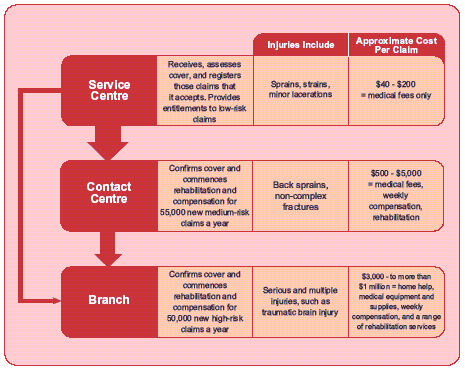
2.22
New claims initially go to one of the two service centres for registration. The lowrisk
claims can be processed and closed almost immediately, as they may involve
simply processing a payment for a single doctor’s visit. Specialist teams at the
service centres process sensitive, medical misadventure, and fatality claims.
2.23
Claims assessed as medium-risk at the service centres are sent to a contact centre
for processing by case co-ordinators. Medium-risk claims may, for example,
involve compensation and some rehabilitation, and be resolved within six weeks.
If the claim is not resolved in this time, it is sent to a branch for more intensive
management by a case manager.
2.24
High-risk claims are complex by nature and have been assessed as requiring
assistance from ACC for more than six weeks. These claims are sent straight to
the branches. The branches also manage long-term claims that have received
ACC assistance for more than 12 months.
2.25
In the context of ACC’s overall work, the complicated and lengthy claims are few
in number but high in costs. Of the approximately 1.5 million claims that ACC
receives each year, only about 105,000 (7%) require rehabilitation and compensation,
and hence management, either at ACC’s contact centres or branches. Of the 105,000,
around 7% go on to become long-term claims – claims that receive assistance from
ACC for more than 12 months. At present, the pool of long-term claims makes
up about two-thirds of ACC’s compensation and rehabilitation costs.
2.26
While the claims managed at the branch level make up only a small part of all
claims received by ACC in a given year, these claims involve intensive management
and are the most expensive to resolve. The branches are also more exposed
to complaints, reviews, and appeals because of the complexity of the claims that
they process.
2.27
Staff at ACC service centres and contact centres usually communicate with
claimants by letter or telephone, and do not need to have face-to-face contact.
On the other hand, staff at branches have a high level of personal contact with
claimants because of the more intensive style of management that is required.
This is reflected in the number of branches located throughout the country.
Case Management Method
2.28
Case management is the method ACC uses at its branches to manage the
rehabilitation of claimants – that is, to restore a claimant to their condition of
pre-accident health and independence, or as close to that as their injury permits.
2.29
ACC introduced case management during the mid-1990s. An information
pamphlet for claimants published at the time said that ACC’s aim was to take …
a strategic approach to processing, communicating and decision making on each claim
with the express goal of minimising the impact of an injury on the claimant, community
and premium payer19.
2.30
Case management involves one person at ACC (a case manager) becoming
primarily responsible for managing a claim, rather than previously when several
people each dealt with only particular parts of the claim, such as payments.
2.31
The change to case management represented a significant challenge for those
ACC staff members whose role changed from claim processing to active case
management.
2.32
ACC described the key features of case management20 as:
- early intervention, particularly the earliest possible identification of the claimant’s total needs;
- integrated service planning and delivery in partnership with the claimant, family, employer, and health and rehabilitation professionals;
- proactive monitoring of the effectiveness, quality, and costs of services delivered; and
- continuous review and updating of the claimant’s case management plan (a predecesser to the Individual Rehabilitation Plan).
2.33
In August 200221, ACC re-stated the key features of effective case management as:
- identifying a claimant’s needs;
- providing appropriate medical treatment, encompassing mental and physical rehabilitation;
- providing daily living support if necessary; and
- providing vocational training or re-training, where appropriate.
2.34
Figure 3 on the opposite page shows the divisions and units of ACC that have
primary responsibility for case management. Divisions and units that are not
noted in Figure 3 are primarily involved with the delivery of corporate services,
which are outside the scope of this audit.
Figure 3
ACC Divisions and Units With Case Management Responsibilities
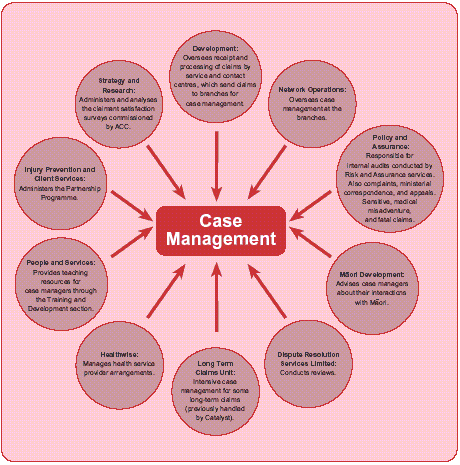
2.35
Some large companies that require a tailored approach to managing their
workplace injuries have a contractual arrangement with ACC known as the
Partnership Programme (as mentioned in Figure 3), whereby the company
manages workplace injuries on behalf of ACC in exchange for levy discounts.
This programme was outside the scope of our audit.
Corporate Philosophy
2.36
ACC views its rehabilitation philosophy as working in partnership with
claimants (and others) to:
- identify needs;
- provide appropriate support and entitlements;
- assist in the restoration of the claimant’s functions; and
- facilitate participation that contributes to the claimant’s quality of life.
2.37
ACC relies on, and places emphasis on establishing and maintaining relationships
with, health service providers to achieve the best possible treatment and
rehabilitation outcomes for claimants.
Organisational Structure
2.38
ACC delivers its services through six business units and eight corporate divisions,
as shown in Figure 4 on the opposite page:
2.39
In addition, ACC:
- contracts health service providers; and
- consults advisory groups.
Health Service Providers
2.40
ACC relies on a number of health service providers to treat and rehabilitate claimants.
Section 6 of the Act defines the providers of various health services, and ACC has a
responsibility to contract only those providers who demonstrate and maintain high
professional competence.
Figure 4
ACC’s Organisational Structure
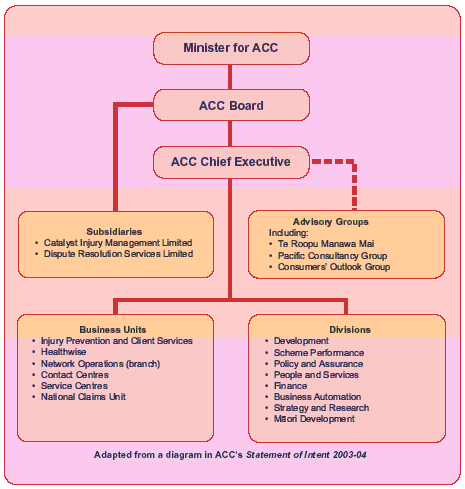
2.41
ACC contracts and pays:
- Treatment providers who, according to ACC criteria, are competent to provide specific treatment. There are 14 types of provider listed in this category, such as physiotherapists and acupuncturists.
- Registered health professionals who can provide medical certificates for a claimant’s first week off work. There are also 14 health professional groups registered by ACC, such as general practitioners and pharmacists.
- Medical and occupational assessors who perform the assessments required for the IRP22, and the vocational independence processes.
2.42
Some providers fall within more than one of the three groups listed above.
2.43
Many other providers provide a range of social and vocational rehabilitation
services, such as home help and child care.
2.44
When health service providers register with ACC they are allocated a provider
number, which then allows them to receive payment for treatment services.
2.45
However, ACC is now using a more rigorous registration system, which requires
all health service providers to have specific qualifications, and to meet licensing,
certification, and other requirements. This system will show the current
professional status of each health service provider, and will collect data on an
individual claimant’s treatment regime. The registration system sets a consistent
standard for health service providers, for the dual benefit of claimants and ACC.
Advisory Groups
2.46
In January 2003, ACC announced the formation of the Consumers’ Outlook Group
as a means of seeking community advice on claimant service issues, to identify
and prioritise issues of concern, and to further assist ACC in working with
claimants. The group is made up of people involved with community organisations
that represent ACC claimants, and meets every three months with members of
ACC’s senior management team, including the Chief Executive.
2.47
Although it was still establishing its terms of reference at the time of our field
work, we consider that the Consumers’ Outlook Group is an effective means of
drawing ACC’s attention to concerns about service delivery. We support the
emphasis that ACC has placed on obtaining community input into its activities.
2.48
For the last few years, ACC has consulted with an external Māori strategic
advisory group called Te Roopu Manawa Mai, about every three months.
This group, which includes academics and researchers, provides advice on the
appropriateness of ACC’s strategies and policies for responsiveness to Māori.
ACC’s Pou Arahi (General Manager Mäori Development) has identified better use
of the group as a priority.
2.49
In addition, ACC has appointed nine Pae Arahi, who are Māori people contracted
to liaise between the Māori community and ACC branches in their area. The Pae
Arahi also advise case managers on matters of tikanga.23 The benefit of the Pae
Arahi position as a support for case managers is discussed further in paragraph
4.24 on page 60.
2.50
Towards the end of 2000, ACC and the Pacific Consultancy Group signed a
protocol outlining joint responsibility for improving ACC’s service delivery to
Pacific peoples.24 The group is made up of professionals from various Pacific
communities, selected for their extensive business, education, community and
economic development, research, and health experience. The group assists
ACC’s participation in programmes that aim to improve rehabilitation outcomes
for Pacific peoples, and improve their awareness of ACC services.
2.51
We support ACC’s continuing interaction with the Pacific Consultancy Group, as
the group’s advice is assisting to improve ACC policies and strategies in treatment
services and rehabilitation for Pacific peoples.
2.52
ACC has also initiated consultation with various liaison groups that represent
health service providers, with the aim of discussing issues such as technological
developments in lodging ACC claim registration forms, and new treatment
manuals.
2.53
Two advisory groups have been formed to provide assistance to the Minister for
ACC. One is the ACC Ministerial Advisory Group, which provides independent
and specialist advice on ACC’s operation, design, and performance. The other is
the Ministerial Advisory Panel on Work-Related Gradual Process, Disease or
Infection, which provides independent advice in this area.25 We did not review
the activities of these groups.
Figure 5
Location of ACC Offices
Service Delivery Locations
2.54
ACC employs about 2000 full-time-equivalent staff, which includes about 388
full-time-equivalent case manager positions. Work locations comprise Head
Office, two service centres, four contact centres, and 30 branches, as shown in
Figure 5. ACC case managers also participate in the Heartland Services
programme (see paragraph 3.35 on page 50), which helps to provide services to
areas without a branch.
10: Section 3(c).
11: Sections 8 and 20-22.
12: Personal injury is defined in section 26 and accident is defined in section 25.
13: Section 69.
14: If the injured person is employed their employer is liable to pay the first week of compensation to which the person is entitled.
15: Section 6.
16: Section 6.
17: Accident Compensation Corporation Annual Report 2003, page 2.
18: In this context, “risk” means the extent of the injury, the likely duration of incapacity, and factors including the claimant’s age, occupation, and previous injury history.
19: ACC Case Management Q & A, page 1.
20: ACC Case Management Q & A, page 1.
21: Accident Compensation Corporation – Briefing to the Incoming Minister, August 2002, page 20.
22: The Act requires that an Individual Rehabilitation Plan be prepared for all claimants who will require cover for more than 13 weeks – see paragraphs 4.35-4.52 on pages 62-65.
23: Māori customary values and practices.
24: Accident Compensation Corporation Annual Report 2003, page 48.
25: Press release by Hon Ruth Dyson, ACC advisory groups will strengthen stakeholder voice, 30 June 2003.
page top
